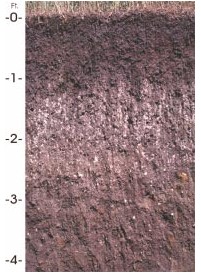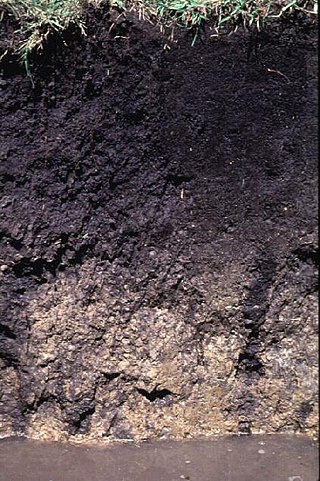The topic of this article may not meet Wikipedia's general notability guideline .(April 2013) |
Narragansett soils are loamy soils occurring in the northeastern United States. It is the state soil of Rhode Island.
The topic of this article may not meet Wikipedia's general notability guideline .(April 2013) |
Narragansett soils are loamy soils occurring in the northeastern United States. It is the state soil of Rhode Island.
“Narragansett” is the name of the town where the soil was first classified. The town was named for the indigenous Narragansett tribe. Narragansett is an English corruption of Nanhigganeuck, their actual name meaning "people of the small point."
Narragansett's soils are found in upland areas of Rhode Island, where they occupy approximately 12,000 acres (49 km2), and in the adjacent states of Connecticut and Massachusetts. [1] This soil type has been unofficially named the State Soil of Rhode Island. [2]
The Narragansett soil series consists of coarse-loamy over sandy or sandy-skeletal, mixed, active, mesic Typic Dystrudepts. [1] [lower-alpha 1] [3] They are well-drained, loamy soils that formed in friable (ablation) glacial till mantled with a silty loess cap.
These are productive agricultural soils. Silage corn, hay, and vegetables are the principal crops. [4] Oaks, white pine, and beech are the most common forest species. Many areas are used for residential development. The average annual precipitation in areas with this soil type ranges from 40 to 50 inches. The average annual temperature is 45 to 52 °F. [1]

Charlestown is a town in Washington County, Rhode Island, United States. The population was 7,997 at the 2020 census.

Narragansett is a town in Washington County, Rhode Island, United States. The population was 14,532 at the 2020 census. However, during the summer months the town's population more than doubles to near 34,000. The town of Narragansett occupies a narrow strip of land running along the eastern bank of the Pettaquamscutt River to the shore of Narragansett Bay. It was separated from South Kingstown in 1888 and incorporated as a town in 1901.

Tunbridge is a town in Orange County, Vermont, United States. As of the 2020 United States Census the town population was 1,337. The town consists of three village centers, all situated on Vermont Route 110 in the valley of the first branch of the White River. The three settlements are named North Tunbridge, Tunbridge Village ("Market") and South Tunbridge ("Jigger").

Narragansett Bay is a bay and estuary on the north side of Rhode Island Sound covering 147 square miles (380 km2), 120.5 square miles (312 km2) of which is in Rhode Island. The bay forms New England's largest estuary, which functions as an expansive natural harbor and includes a small archipelago. Small parts of the bay extend into Massachusetts.

Aquidneck Island, also known as Rhode Island, is an island in Narragansett Bay in the state of Rhode Island. The total land area is 97.9 km2 (37.8 sq mi), which makes it the largest island in the bay. The 2020 United States Census reported its population as 60,109. The state of Rhode Island is named after the island; the United States Board on Geographic Names recognizes Rhode Island as the name for the island, although it is widely referred to as Aquidneck Island in the state and by the island's residents.

The Pokanoket was the village governed by Massasoit. The term broadened to refer to all peoples and lands governed by Massasoit and his successors, which were part of the Wampanoag people in what is now Rhode Island and Massachusetts.

Shinyanga Region is one of Tanzania's 31 administrative regions. The region covers a land area of 18,555 km2 (7,164 sq mi). The region is comparable in size to the combined land area of the nation state of Fiji. The region is bordered to the north by the Mwanza, Mara, and Kagera Regions and to the south by the Tabora Region. In addition, the Kigoma Region borders the region to the west, and the Simiyu Region and a sliver of Singida Region to the east. The regional capital is the municipality of Shinyanga. According to the 2012 national census, the region had a population of 1,534,808.
Narragansett may refer to:
Hukkeri is a Town Municipal Council and taluka in Belgavi district in the Indian state of Karnataka.

Bama is the official state soil of Alabama.
The Paxton soil series was established in Worcester County, Massachusetts in 1922, and is named for the town of Paxton where it was first described and mapped, and is the state soil of Massachusetts.

Antigo soils are among the most extensive soils in Wisconsin. They occur on about 300,000 acres (1,200 km²) in the northern part of the State. Antigo soils are well-drained and formed under northern hardwood forests in loess and loamy sediments over stratified sandy outwash. The average annual precipitation ranges from 28 to 33 inches, and the average annual air temperature ranges from 39 to 45 °F. The soil series was named after the city of Antigo, Wisconsin.
Tifton soil is the official state soil of the state of Georgia.
Manasa is a town with nagar palika in Neemuch district in the Indian state of Madhya Pradesh. It was under the princely state of Holker before Indian independence.

Houdek is a type of soil composed of glacial till and decomposed organic matter. The soil series was established in 1955 in Spink County, South Dakota. It is unique to the United States, but in particular to South Dakota where it is the state soil.

Chepiwanoxet is a neighborhood in Warwick, Rhode Island, with an island peninsula in Greenwich Bay, an arm of Narragansett Bay. The neighborhood straddles the Amtrak railroad lines, which lies just east of and parallel to the Post Road. Its boundaries are Neptune Street to the North, Alger Avenue to the South, Post Road to the West, and Greenwich Bay to the East. Chepiwanoxet Way, an underpass beneath the Amtrak lines, now serves as the only street access in and out of the neighborhood.

The Drummer soil series is the state soil of Illinois.

Washington County, known locally as South County, is a county located in the U.S. state of Rhode Island. As of the 2020 census, the population was 129,839. Rhode Island counties have no governmental functions other than as court administrative boundaries, which are part of the state government.

Simiyu Region is one of Tanzania's 31 administrative regions. The region covers a land area of 25,212 km2 (9,734 sq mi). The region is comparable in size to the combined land area of the nation state of North Macedonia. The region is bordered to the north by the Mara Region, to the south by the Shinyanga Region and Singida Region. Mwanza Region borders the region to the west through Lake Victoria, and Arusha Region to the east. The region is home to the Serengeti National Park, a UNESCO World Heritage Site, shared with Mara Region. The regional capital is the town of Bariadi. According to the 2012 national census, the region had a population of 1,534,808.

The geology of Rhode Island is based on nearly one billion year old igneous crystalline basement rocks formed as part of the microcontinent Avalonia that collided with the supercontinent Gondwana. The region experienced substantial folding associated with its landlocked position during the Alleghanian orogeny mountain building event. The region accumulated sedimentary rocks, including small deposits of coal. The region was covered with thick Atlantic Coastal Plain sediments, with the erosion of the Appalachians and the creation of the Atlantic Ocean throughout the past 200 million years. These surficial sediments and soils were substantially reworked by the Pleistocene glaciations. The state's geology is part of the broader geology of New England.